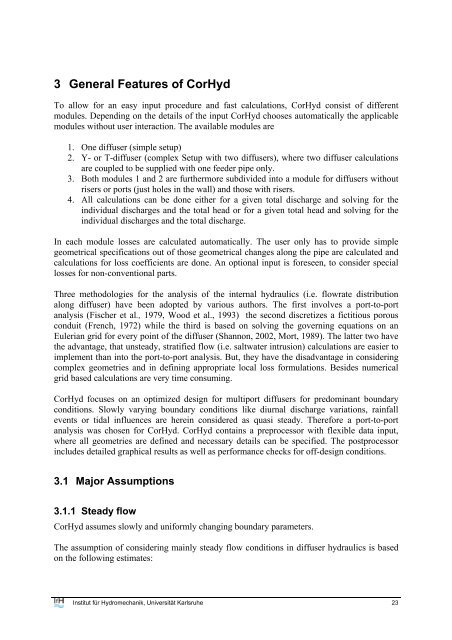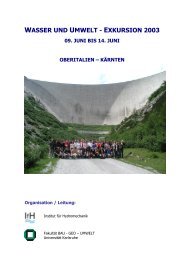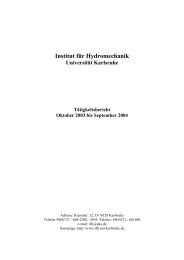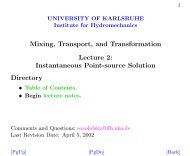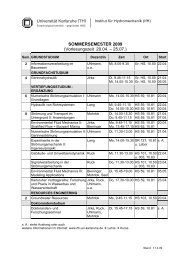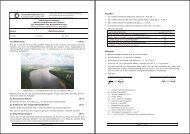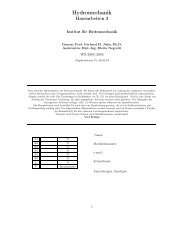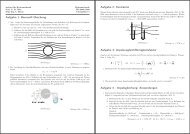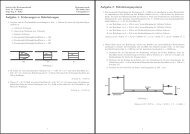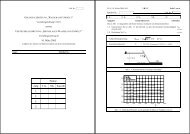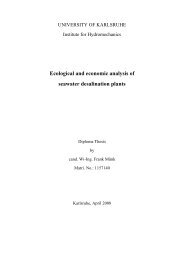user's manual for corhyd: an internal diffuser hydraulics model - IfH
user's manual for corhyd: an internal diffuser hydraulics model - IfH
user's manual for corhyd: an internal diffuser hydraulics model - IfH
You also want an ePaper? Increase the reach of your titles
YUMPU automatically turns print PDFs into web optimized ePapers that Google loves.
3 General Features of CorHyd<br />
To allow <strong>for</strong> <strong>an</strong> easy input procedure <strong>an</strong>d fast calculations, CorHyd consist of different<br />
modules. Depending on the details of the input CorHyd chooses automatically the applicable<br />
modules without user interaction. The available modules are<br />
1. One <strong>diffuser</strong> (simple setup)<br />
2. Y- or T-<strong>diffuser</strong> (complex Setup with two <strong>diffuser</strong>s), where two <strong>diffuser</strong> calculations<br />
are coupled to be supplied with one feeder pipe only.<br />
3. Both modules 1 <strong>an</strong>d 2 are furthermore subdivided into a module <strong>for</strong> <strong>diffuser</strong>s without<br />
risers or ports (just holes in the wall) <strong>an</strong>d those with risers.<br />
4. All calculations c<strong>an</strong> be done either <strong>for</strong> a given total discharge <strong>an</strong>d solving <strong>for</strong> the<br />
individual discharges <strong>an</strong>d the total head or <strong>for</strong> a given total head <strong>an</strong>d solving <strong>for</strong> the<br />
individual discharges <strong>an</strong>d the total discharge.<br />
In each module losses are calculated automatically. The user only has to provide simple<br />
geometrical specifications out of those geometrical ch<strong>an</strong>ges along the pipe are calculated <strong>an</strong>d<br />
calculations <strong>for</strong> loss coefficients are done. An optional input is <strong>for</strong>eseen, to consider special<br />
losses <strong>for</strong> non-conventional parts.<br />
Three methodologies <strong>for</strong> the <strong>an</strong>alysis of the <strong>internal</strong> <strong>hydraulics</strong> (i.e. flowrate distribution<br />
along <strong>diffuser</strong>) have been adopted by various authors. The first involves a port-to-port<br />
<strong>an</strong>alysis (Fischer et al., 1979, Wood et al., 1993) the second discretizes a fictitious porous<br />
conduit (French, 1972) while the third is based on solving the governing equations on <strong>an</strong><br />
Euleri<strong>an</strong> grid <strong>for</strong> every point of the <strong>diffuser</strong> (Sh<strong>an</strong>non, 2002, Mort, 1989). The latter two have<br />
the adv<strong>an</strong>tage, that unsteady, stratified flow (i.e. saltwater intrusion) calculations are easier to<br />
implement th<strong>an</strong> into the port-to-port <strong>an</strong>alysis. But, they have the disadv<strong>an</strong>tage in considering<br />
complex geometries <strong>an</strong>d in defining appropriate local loss <strong>for</strong>mulations. Besides numerical<br />
grid based calculations are very time consuming.<br />
CorHyd focuses on <strong>an</strong> optimized design <strong>for</strong> multiport <strong>diffuser</strong>s <strong>for</strong> predomin<strong>an</strong>t boundary<br />
conditions. Slowly varying boundary conditions like diurnal discharge variations, rainfall<br />
events or tidal influences are herein considered as quasi steady. There<strong>for</strong>e a port-to-port<br />
<strong>an</strong>alysis was chosen <strong>for</strong> CorHyd. CorHyd contains a preprocessor with flexible data input,<br />
where all geometries are defined <strong>an</strong>d necessary details c<strong>an</strong> be specified. The postprocessor<br />
includes detailed graphical results as well as per<strong>for</strong>m<strong>an</strong>ce checks <strong>for</strong> off-design conditions.<br />
3.1 Major Assumptions<br />
3.1.1 Steady flow<br />
CorHyd assumes slowly <strong>an</strong>d uni<strong>for</strong>mly ch<strong>an</strong>ging boundary parameters.<br />
The assumption of considering mainly steady flow conditions in <strong>diffuser</strong> <strong>hydraulics</strong> is based<br />
on the following estimates:<br />
Institut für Hydromech<strong>an</strong>ik, Universität Karlsruhe 23


